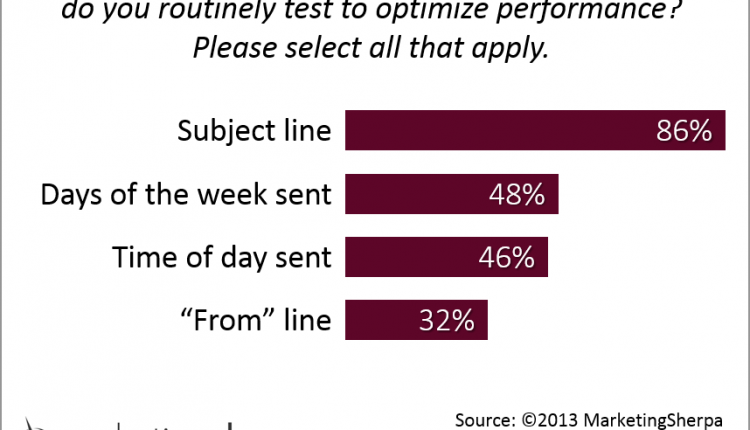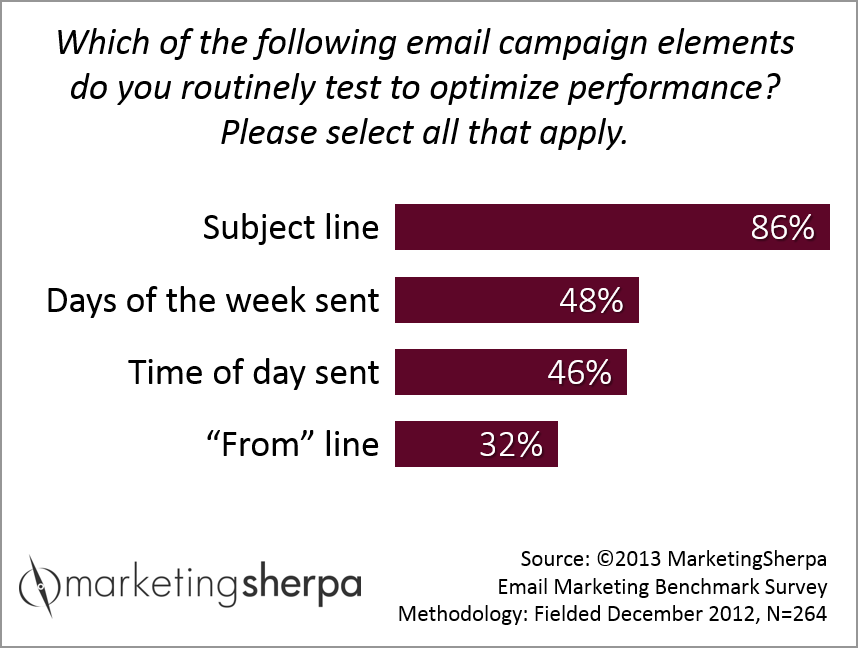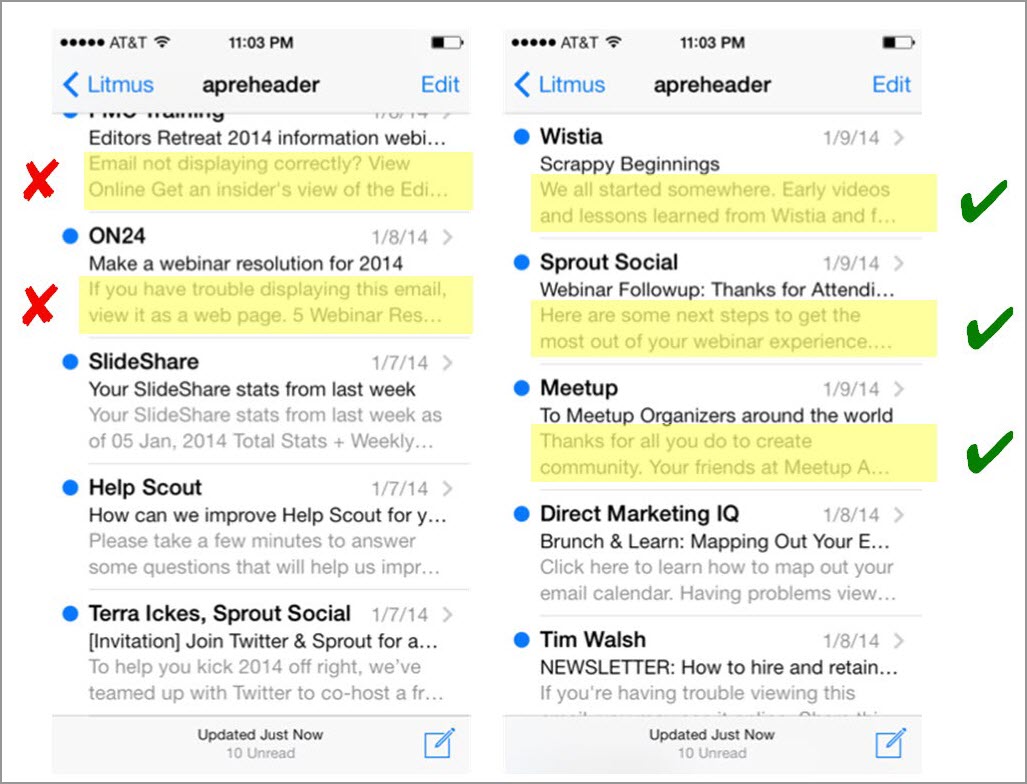Email is a great medium for testing. It’s low cost, and typically requires less resources than website testing. It’s also near the beginning of your funnel, where you can impact a large portion of your customer base.
Sometimes it can be hard to think of new testing strategies, so we’ve pulled from 20 years of research and testing to provide you with a launching pad of ideas to help create your next test.
In this post and next Monday’s, we’re going to review 16 testing opportunities you can test around seven email campaign elements.
To start you out, let’s look at nine opportunities that don’t even require you to change the copy in your next email.
Subject Line Testing
Testing Opportunity #1. The sequence of your message
Recipients of your email might give your subject line just a few words to draw them in, so the order of your message plays an important role.
In the MarketingExperiments Web clinic “The Power of the Properly Sequenced Subject Line: Improve email performance by using the right words, in the right order,” the team reviewed several tests that demonstrate the importance of thought sequence in your subject lines.
Try testing point-first messaging. Start with what the recipient will get from your message and the email.
By reordering the thought sequence — plus adding a few more tangible of details — the below subject line test saw a 10% relative increase in opens and the clickthrough rate increased by 15%.
Testing Opportunities #2 and #3. Internal issues and external events to build relevance
In the Web clinic, “Subject Lines that Convert: A review of 100+ successful subject lines reveals what motivates people to open (or delete) an email,” the team identified two ways to immediately connect with subscribers through the subject line: an internal issue or an external issue.
First, let’s look at an example of internal issues.
From This — Subject Line: [Company Name]: A New Way to Order
To This — Subject Line: [Company Name]: Now only 2-meal minimum order
The first subject line is vague and doesn’t clearly connect to why the subscriber should care. The second subject line connects to an issue that some of customers might have internally felt in the past. This built relevance to their wants and needs, enticed them to open the email and resulted in a 25.3% lift.
However, the greater impact is seen in clickthrough. Because the subject line clearly communicated a new solution to a known internal problem, subscribers opened the email with more interest and motivation, resulting in a 196% increase in clicks.
Check out this list of potential internal issues you can explore in your subject line testing:
- Limited resources (time, money and help)
- Unmet expectations (work and family)
- Deficient skillsets (inability or inadequacy)
- Operational difficulties (routine usability)
- Fragmented perspectives (ignorance or misunderstanding)
Next, let’s review an external event subject line test.
From This — Subject Line: It’s easy to access your [Bank Name] Accounts Online. Sign On Now
To This — Subject Line: [Name], Your Account Information Is Ready To View
The first subject line is a general statement. It’s easy to access. Okay. You want me to sign on. Okay. But why? Why should I sign on now? It hasn’t connected an event with why I should take that step.
However, the second subject line states my information is now ready to view. Something has occurred. It gives me a reason to sign on. By providing a reason to sign on, it increased opens by 92.2% over the first subject line.
Here are a few other types of external events to consider when trying to build relevance:
- An action or behavior
- A conversation
- A single exchange (completed or abandoned)
- A cancellation (membership, contract or recurring transactions)
- A service interaction
Preheader Copy Testing
Testing Opportunity #4. Value copy in preheader
One area of the email is often overlooked is the preheader text. However, many inboxes, both mobile and desktop, allow subscribers to see these extra 35 or so characters before opening your email. And what message are you sending with the text, “If you have trouble displaying this email, view it as a webpage”? Should I often expect problems with your email? Should I bother opening it if I do?
This space is an opportunity to add more value to your email and entice subscribers to open.
According to Justine Jordan, Marketing Director, Litmus, at a past MarketingSherpa Email Summit, you want the preheader copy to “tie into the subject line, bringing [readers] in and encouraging the click.”
Justine provided a few good examples she has come across.
“From” Field Testing
Testing Opportunity #5. Company versus person’s name
If you’ve been a long-time reader of MarketingExperiments, you’ve probably heard us say, “People don’t buy from companies; people buy from people.” This would could be a great test for your next email send. If your emails normally come from your company name, you might try humanizing your email by using the name of a prominent figure in your organization.
Testing Opportunity #6. Executive versus customer-involved employee
Once you determine that sending emails from a person works better, it could be worth a test to find the right person. While subscribers might recognize your CEO, they also know the chances of the CEO being directly involved in the email are slim. A lower-level employee with a title that connects to what your email is about could be found more favorable by subscribers because they might see that person as more real and involved. The email won’t feel faked.
Email Send Time Testing
In the Web clinic, “When Should You Send An Email? How one of the largest banks in the world discovered when to send its emails,” the MECLABS team revealed research about email send time based on multiple experiments in the MECLABS research library. The clinic detailed three testing opportunities around email send time.
Testing Opportunity #7. The time of day
Timing can greatly impact not only if your emails are opened, but the engagement level you achieve beyond the open.
Early morning sends could get subscribers to open on their commutes, but will they take action on a mobile device? Or would an afternoon send get lost in a crowded inbox?
A large financial institution wanted to increase the number of completed applications it received from an email. To do so, it tested two times of day: 3 a.m. versus 3 p.m. The 3 p.m. send time saw a 13.5% increase in clickthrough.
Testing Opportunity #8. The day of the week
The above time of day experiment also tested all seven days of the week. While Tuesday has often been cited as a good day to send emails, it performed the lowest. The best performing day: Sunday, with a 23.2% lift in clickthrough rate over Tuesday.
Remember, there is not a magical best day or time. Test and let your audience tell you which day (and time) works best for them. Even when testing the same group of people, different products or services could change the day or time the group is likely to respond. What works for B2C might not work for B2B. And what works for grocery stores might not work for media streaming brands.
Testing Opportunity #9. Frequency
The clinic identified a third opportunity in the email timing area: frequency. A large ecommerce company wanted to find the optimal send frequency for a portion of its list. For the company, this meant the frequency that would generate the most revenue without increasing the unsubscribe rate.
The team segmented the group into seven email frequencies:
- 21 days
- 14 days
- 10 days
- 7 days
- 5 days
- 3 days
- 2 days
The team determined that when sending the email at the rate of once a week, the company would miss three times the amount of revenue it could be making if sending every other day without negatively affecting unsubscribes or the open rate.
That’s a huge potential lift in projected monthly revenue, and definitely worth a test for your list.
Stay tuned
Check back on Monday for the second portion of our email testing opportunities compilation, when we review experiment ideas around your design, body copy and calls-to-action.
You can follow Selena Blue, Manager of Editorial Content, MECLABS Institute on Twitter at @SelenaLBlue.
You may also like
Email Marketing Chart: How send frequency impacts read rate [MarketingSherpa Chart]
Collaborative A/B Testing: Consumer Reports increases revenue per donation 32% [MarketingSherpa Case Study]
Email Marketing: Preheader testing generates 30% higher newsletter open rate for trade journal






